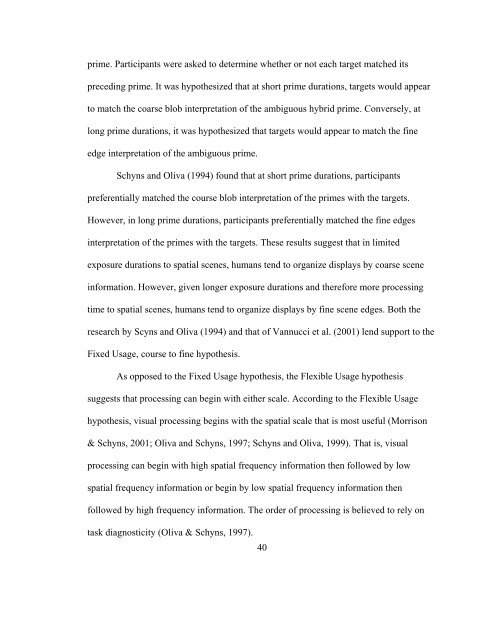The Use of Iambic Pentameter in the
The Use of Iambic Pentameter in the
The Use of Iambic Pentameter in the
You also want an ePaper? Increase the reach of your titles
YUMPU automatically turns print PDFs into web optimized ePapers that Google loves.
prime. Participants were asked to determ<strong>in</strong>e whe<strong>the</strong>r or not each target matched its<br />
preced<strong>in</strong>g prime. It was hypo<strong>the</strong>sized that at short prime durations, targets would appear<br />
to match <strong>the</strong> coarse blob <strong>in</strong>terpretation <strong>of</strong> <strong>the</strong> ambiguous hybrid prime. Conversely, at<br />
long prime durations, it was hypo<strong>the</strong>sized that targets would appear to match <strong>the</strong> f<strong>in</strong>e<br />
edge <strong>in</strong>terpretation <strong>of</strong> <strong>the</strong> ambiguous prime.<br />
Schyns and Oliva (1994) found that at short prime durations, participants<br />
preferentially matched <strong>the</strong> course blob <strong>in</strong>terpretation <strong>of</strong> <strong>the</strong> primes with <strong>the</strong> targets.<br />
However, <strong>in</strong> long prime durations, participants preferentially matched <strong>the</strong> f<strong>in</strong>e edges<br />
<strong>in</strong>terpretation <strong>of</strong> <strong>the</strong> primes with <strong>the</strong> targets. <strong>The</strong>se results suggest that <strong>in</strong> limited<br />
exposure durations to spatial scenes, humans tend to organize displays by coarse scene<br />
<strong>in</strong>formation. However, given longer exposure durations and <strong>the</strong>refore more process<strong>in</strong>g<br />
time to spatial scenes, humans tend to organize displays by f<strong>in</strong>e scene edges. Both <strong>the</strong><br />
research by Scyns and Oliva (1994) and that <strong>of</strong> Vannucci et al. (2001) lend support to <strong>the</strong><br />
Fixed Usage, course to f<strong>in</strong>e hypo<strong>the</strong>sis.<br />
As opposed to <strong>the</strong> Fixed Usage hypo<strong>the</strong>sis, <strong>the</strong> Flexible Usage hypo<strong>the</strong>sis<br />
suggests that process<strong>in</strong>g can beg<strong>in</strong> with ei<strong>the</strong>r scale. Accord<strong>in</strong>g to <strong>the</strong> Flexible Usage<br />
hypo<strong>the</strong>sis, visual process<strong>in</strong>g beg<strong>in</strong>s with <strong>the</strong> spatial scale that is most useful (Morrison<br />
& Schyns, 2001; Oliva and Schyns, 1997; Schyns and Oliva, 1999). That is, visual<br />
process<strong>in</strong>g can beg<strong>in</strong> with high spatial frequency <strong>in</strong>formation <strong>the</strong>n followed by low<br />
spatial frequency <strong>in</strong>formation or beg<strong>in</strong> by low spatial frequency <strong>in</strong>formation <strong>the</strong>n<br />
followed by high frequency <strong>in</strong>formation. <strong>The</strong> order <strong>of</strong> process<strong>in</strong>g is believed to rely on<br />
task diagnosticity (Oliva & Schyns, 1997).<br />
40

















